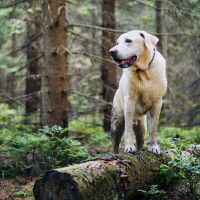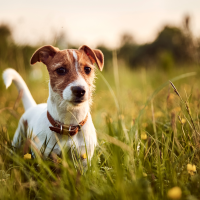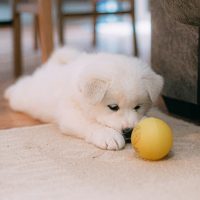What is separation anxiety?
Separation anxiety, or separation distress, is when a dog experiences a feeling of anxiety or even panic when they are separated from their preferred people. The signs most commonly associated with this disorder include: vocalization, salivation, destructive behavior (especially at exits like doors and windows), escape attempts, urination or defecation indoors or in unwanted locations, lack of appetite when alone, self-trauma (like licking or chewing) when alone, and attempted or successful escapes. In severe cases, dogs may become so panicked that they break through fences or windows, chew through walls or doors, and engage in other dangerous behavior when they are feeling panic. Often, the signs of anxiety (pacing, panting, jumping up on the owner, attention-seeking behavior, avoiding confinement areas, or trying to escape) begin when the owner first starts preparing to leave home (brushing teeth, picking up keys, lacing up shoes, etc.). If your pet is showing any of these signs, contact your veterinarian. A diagnosis is needed to confirm separation distress or separation anxiety disorder, but there is good news. There is much that can be done to help prevent and treat separation anxiety.
How can I meet the needs of my dog to help prevent separation anxiety?
Dogs must have their daily needs met in order to remain both physically and mentally healthy. A dog’s basic daily needs include proper nutrition, medical care, and grooming. Some other daily needs include: physical exercise, mental stimulation, training, positive reinforcement, structured games, protection from stress or fear, social interaction, exploration of new environments, and time for calm and rest.
Developing a routine that ensures your dog’s needs are met on a daily basis is very important. Routines build predictability, which helps life feel more stable and less uncertain. Stability reduces anxiety in people and in animals. The routine does not need to be strict, meaning the same activity at the same time every day, but it should be regular. This allows time for each activity, each day. Maintaining a routine can help protect against separation distress, especially as the dog’s family spends more time away from the home.
Common signs of stress to look for:
- Refusing treats
- Taking treats roughly when normally gentle
- Dilated pupils/wide eyes
- Furrowed brow
- Ears held down or to the side
- Pacing
- Panting when not hot
- Shaking off when not wet
- Licking lips in the absence of food
- Yawning when not tired
- Looking/moving away from stressors
- Tail held low or tucked
- Head held low
- Looking away or moving away
- Being overly solicitous
- Attention-seeking (jumping, pawing, licking)
- Fidgety, cannot settle
- Moving slower than normal
- Tense muscles
- Trembling
- Vocalization
Any training program should not be stressful for your dog. This means staying “below threshold.” Threshold refers to the stage when a dog reacts to something. For example, if your dog is calm when a strange dog is sitting 20 feet away but begins barking when that dog moves just one foot closer, your dog’s threshold has been exceeded. Your dog will need assistance to return to a calm state.
When working on training exercises, “below threshold” means your dog is not showing any signs of stress and appears willing to participate in training. A dog should not be placed in a stressful situation intentionally. Forcing a dog to confront their fears is called “flooding”. Flooding can result in emotional harm that is difficult or impossible to reverse in some cases. It is also too risky to include in training and behavior modification exercises.
What is independence training?
Teaching pets to be on their own without being overly attached to a specific person is helpful in building a pet’s coping ‘toolbox’ and having them adapt to changes in schedules and lifestyles. Independence training helps a dog to be comfortable when the owner is absent and to relax without needing to follow the owner each time they move. This may reduce the risk of hyper-attachment.
Downtime: Build time into a dog’s day for naps or relaxation, without human interaction. Offer a chew toy, food dispensing toy, stuffed treat holder, or meal in the desired “downtime” location. Tethering or anchoring the food dispenser to the downtime location can help encourage the dog to remain in one place and prevents them from following the owner while carrying the food treats along for the ride.
If the dog is comfortable, simply provide the distraction/reward device and move on with your activities. If the dog displays anxious body language, such as trying to follow you, not engaging with the distraction, folding the ears, dilating the pupils, panting, or other signs of anxiety, stop the exercise and take a break before slowly reintroducing the distraction.
To develop the downtime exercise, start by staying near the downtime mat, bed, etc., with the dog. Quietly encourage them to interact with the food or toy and reward them with low to moderate value food treats for remaining on the mat. The exercise needs to be kept short enough and at a close enough distance so the pet feels comfortable (stays “below threshold”). Gradually, both the distance between the person and the pet and the duration of the exercise can be extended while keeping the pet below threshold.
The downtime exercise helps build and maintain the habit of spending time alone and to engage in quiet, calm, and relaxing behaviors without the company of the owner.
Go to Place: This helpful exercise teaches a dog to settle in a designated location such as a mat, bed, crate, room, or pen and remain there. Go to Place has many useful applications and is also part of independence training.
Use positive reinforcement to teach any new skill to pets. Luring and shaping are techniques that are commonly used to teach new skills, such as Go to Place. The use of a clicker for teaching new skills for dogs is helpful. Clicker training is simple: click when the pet is doing exactly the right thing. After the click, give a treat!
Luring: In this technique, your dog will follow a treat to learn a new skill. Choose a quiet area to work and place the mat, bed, crate, platform, etc. where you want your dog to go.
- Start by standing right next to the place.
- Point to the place and drop one treat there.
- When the pet goes to eat the treat, click when they touch the place and drop another treat.
- Toss a treat away from the place to reset the exercise.
- Repeat steps 1 and 2 until the pet comes quickly to the place when you point.
- Fade the lure: Point to the place. The pet will come quickly to the place. Click, drop a treat on the place. Now is a good time to add a word cue as well such as “Mat”, “Bed”, “Kennel”, “Place”, etc.
- Toss a treat away to reset the exercise.
- Add the step of “down” on the place.
- Begin gradually stepping away from the place. Send the pet from one step away, then two, then three.
If at any time the pet shows hesitance, confusion, or lack of progress, take a step back to the most recent level of difficulty that was successful and try again. The above plan may take two minutes or twenty sessions, depending on the situation. Let the dog set the pace.
Shaping: This technique is a terrific way to teach new skills if the dog is keen to train and the owner has the patience. Shaping is similar to the “Hot and Cold” game many children play. A complex skill is taught by rewarding baby steps toward the goal. At first, the smallest step in the right direction receives a click and treat. As understanding improves, bigger steps toward the goal behavior are required to receive a click and treat.
Stand in a relaxed neutral position near the place. Look at the place but don’t hold eye contact with the pet so they feel free to move around and experiment. Observe the pet’s behavior and watch for any of the following:
- Look at place
- Turn head toward place
- Walk toward place 1 step
- Walk toward place multiple steps
- Lean over place
- Sniff place
- Touch a paw or nose to place
Each of these “guesses” is “hotter” and getting closer to the Go to Place skill. Each one receives a click and treat. Consider rolling or tossing the treat a short distance away from the place to reset the learner for a new attempt. The next level most pets offer includes:
- Touch a paw to place for 1-2 seconds
- Touch more than one paw to place
- Stand on place
- Sit on place
- Down or other known trick on place
- Remain on place for longer periods of time
For these steps, click, drop a treat onto the place, then toss or roll a second treat away to reset for a new attempt. Once the pet chooses to go to and remain on the place, introduce a pointing and word cue to send them to their place. Then, begin adding distance so the pet is being sent away from the person but is settling in their designated spot.
Having trouble? Slow down and accept smaller baby steps. “Split” the baby steps down and watch for the smallest guess that could lead to a right answer. It’s never wrong to reward a baby step, but it can cause problems if rewards are withheld while waiting for a leap in understanding.
What are practice separations?
Practice separations help assess if pets are comfortable being left alone. At first, practice separations might only last a few seconds.Select an area where the pet will be safe such as a crate, room with a baby gate, bed in a pet-proofed room, etc. Smile and calmly say something such as “I’ll be back.” Toss a few treats and then step away out of sight, where the pet can’t get to you. Start with just a few seconds at a time and gradually work up to longer separations.
How do I prepare my dog for longer separations?
If you are not sure if your pet is comfortable alone, a video camera is a terrific tool to check in. Home monitoring cameras, baby monitors, cell phones, and webcams can monitor your pet while you are away. Simply make sure the video is running when the separation takes place. Check in on your pet remotely or review the video when you return. Start with a brief separation of just a moment or two, then gradually work up to longer separations.
What are drama and departure cues?
Departure cues include lacing up shoes, picking up a wallet or handbag, and jingling car keys. When you’re getting ready to leave, do it with no drama, and the same when you return. Be calm, reassuring, and relaxed. Acting sad when you leave, giving lots of attention when you leave and when you return home may be linked to increased pet anxiety about being alone.
When you are at home, pick up your keys now and then. Get dressed in your running shoes or work shoes even if you are not going anywhere. Then stay home and watch a movie or cook dinner. Try to avoid pairing specific actions and activities with leaving home. Practicing these techniques in dogs without separation distress also helps protect them against developing it in the future.
What can you do if separation causes anxiety?
If you are concerned that your pet may have separation distress or separation anxiety, reach out to your veterinarian. Observe your pet’s responses when you leave the home, provide videos of what happened when your pet was alone, and keep a journal of your pet’s behavior. All of this information will help the veterinarian establish a diagnosis. While you are waiting for your appointment, avoid leaving your pet alone. Dog walkers, daycares, pet sitters, safe trips along with you, working from home are all emergency options while working toward a diagnosis.
Separation anxiety can be treated. Usually treatment involves medicines, management (separations or alone time during the first several weeks of treatment should be kept at a minimum), independence training, and an extremely gradual program for safe departures. Support from professionals helps dogs with separation anxiety to have a safe and good quality of life.
© Copyright 2021 LifeLearn Inc. Used and/or modified with permission under license.






